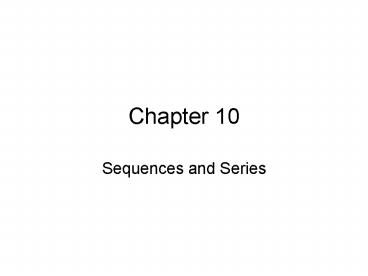Sequences and Series - PowerPoint PPT Presentation
1 / 23
Title:
Sequences and Series
Description:
Is given by either of the following formulas. 1. 2. 10.3 Geometric Sequences ... Use P(k) (and some algebra) to show P(k 1) is true. Prove: For all natural numbers n, ... – PowerPoint PPT presentation
Number of Views:30
Avg rating:3.0/5.0
Title: Sequences and Series
1
Chapter 10
- Sequences and Series
2
10.1 Sequences and Summation Notation
- Definition A sequence is a function f whose
domain is the set of natural numbers. The
values are called terms of the sequence.
3
Example
nth term formula
Sequence
First Term
Second Term
Fourth Term
nth Term
Third Term
4
Recursive Sequences
- Definition A sequence that is defined by
listing the first term, or the first few terms,
and then describes how to determine the remaining
terms from the given ones is recursive.
Example
5
Partial Sums of a Sequence
- For the sequence
- the partial sums are
6
Sigma Notation
- Given
- we can write the sum of the first n terms using
summation notation, or sigma notation. - k is called the index of summation, or summation
variable.
7
Example
End with 5
Start with 1
8
Properties of Sums
9
10.2 Arithmetic Sequences
- Definition An arithmetic sequence is a sequence
of the form - The number a is the first term, and d is the
common difference of the sequence. The nth term
of an arithmetic sequence is given by
10
Partial Sums of Arithmetic Sequences
- For the arithmetic sequence,
- The nth partial sum
- Is given by either of the following formulas.
- 1.
- 2.
11
10.3 Geometric Sequences
- Definition A geometric sequence is a sequence
of the form - The number a is the first term, and r is the
common ratio of the sequence. The nth term of an
arithmetic sequence is given by
12
Partial Sums of Geometric Sequences
- For the geometric sequence
- the nth partial sum
- is given by
13
Sum of an Infinite Geometric Series
- A sum of the form
- is called an infinite series.
- If then the infinite series
- has the sum
14
10.5 Mathematical Induction
- Consider the following sums. Look for a pattern.
The sum of the first 1 odd number is
The sum of the first 2 odd numbers is
The sum of the first 3 odd number is
The sum of the first 4 odd number is
The sum of the first 5 odd number is
15
- Can we make a conjecture about the sum of the
first n odd integers?
The sum of the first n odd integers is
What is the form of any odd integer?
Mathematically, our conjecture now reads
16
Can we prove it?
- A proof is a clear argument that demonstrates the
truth of a statement beyond doubt.
To prove our conjecture, we will use a special
kind of proof called mathematical induction.
17
Mathematical Induction
- To prove something using induction, we need to
establish a sequence of mathematical statements.
We call these statements P1, P2, P3, etc.
The sum of the first 1 odd number is
The sum of the first 2 odd numbers is
The sum of the first 3 odd number is
18
The Key Idea
- Suppose we can prove that whenever one of these
statements is true, the statement following it is
also true. - For every k, if is true, then is
true.
This is called the induction step.
19
Principle of Mathematical Induction
- For each natural number n, let P(n) be a
statement depending on n. Suppose the following
two conditions are satisfied. - P(1) is true.
- For every natural number k, if P(k) is true, then
P(k1) is true. - Then P(n) is true for all natural number n.
20
How It Works.
- Show P(1) is true. The induction step then leads
through if P(1) is true, then P(2) is true. If
P(2) is true, then P(3) is true, etc. - Assume P(k) is true.
- Use P(k) (and some algebra) to show P(k1) is
true.
21
- Prove For all natural numbers n,
Step 1 Show P(1) true.
Step 2 Assume P(k) is true.
Step 3 Show P(k1) is true.
22
Manipulate the left hand side so it looks like
the right hand side.
23
We have now shown that if P(k) is true, P(k1) is
also true. The induction step is completed.
Hence, by the Principle of Mathematical
Induction, for all natural numbers n,































